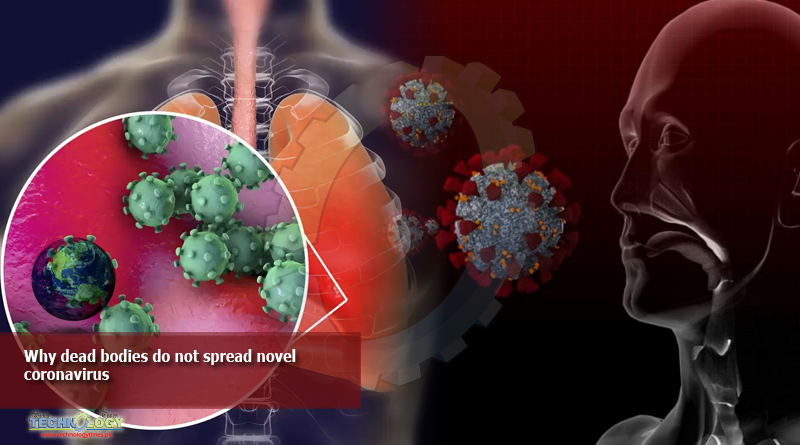The spread novel coronavirus is like a pen drive. The pen drive may contain huge data for storage, transport, copying and visualisation. But none of that can be done unless the USB connector docks onto the port of a computer

The last few weeks have not only seen a significant rise in the number of people in India infected by novel coronavirus (SARS-CoV-2) but also fear and misconception about the ways the virus could spread. While it is indeed true that the virus is highly infectious, scientifically unsubstantiated beliefs about the routes of transmission have only made it worse. As a result, doctors and healthcare workers have been harassed, sick people deserted at a time when they needed care, and even funerals of victims have been violently disrupted. Yet, this phobia and stigmatisation would probably not have happened if only we would have recalled some of our high-school biology.
Here is a short, analogy-based summary of how the pathogen infects the body and why funerals —if done with prescribed guidelines — are nothing to be alarmed about.
Like a pen drive
The virus is like a pen drive. Within itself, a pen drive contains a memory storage chip, a USB controller, some more ‘tiny nuts and bolts’ and sometimes a mini LED light . All this is encased within a metal or plastic case. It is a compact device and the only part that juts out of the case is the USB connector which can fit into the port of a desktop or laptop.
Functionally, the pen drive may contain huge data for storage, transport, copying and visualisation. But none of that can be done unless the USB connector docks onto the port of a computer. It is only then that the pen drive ‘comes to life’ and the data inside can be viewed, edited and copied.
The SARS-CoV-2 virus is very similar to the pen drive. They carry genetic material inside them (a long RNA molecule in case of SARS-CoV-2 – the viral genome) which is the blueprint for making multiple copies of themselves. However, copying this viral genome and making daughter viral particles is possible only when the spike protein (the equivalent of the USB connector) of the virus successfully binds to the ACE2 receptor protein (the equivalent of the USB port) of a host cell. Much has already been published about how the molecular interaction between the spike protein and ACE2 initiates infection of the cell and is beyond the scope of this article. Suffice to say that the docking of spike ‘connector’ on to the ACE2 ‘port’ allows the virus to kick off a series of cellular processes that finally produce plenty of viruses.
How it works
As is well known from our school textbooks, a virus hijacks the cell’s internal systems and commands it to produce only biomolecules needed for making more viruses. Finally, the infected cell bursts open and numerous viral particles are released, which, in turn, infect neighbouring cells or be carried out as part of droplets in human breath.
The organelles in a cell that are essential to produce multiple new viruses need energy; the main source of biochemical energy is adenosine triphosphate (ATP) — the universal energy currency of cells. Virus production needs ATP, but once a person is dead, the cells stop making ATP. To go back to the analogy, ever heard of a pen drive that works on a computer that is switched off and has no battery? No, that is not possible.
But why would cells would stop making ATP almost immediately after death? ATP production in our cells happens in the mitochondria, and the two main raw materials needed are glucose and fats (from our digested food) and oxygen (from our lungs). The oxygen is delivered to the tissues by haemoglobin, the oxygen-transporting protein of blood. Life, as we know it, is heavily based on mitochondrial ATP production and without oxygen, the mitochondrial ATP production comes to a halt. Whatever is already there will supply for a very short time, but spread novel coronavirus that is it. That is the equivalent of ‘power off’. Hence it is a biochemical reality that a dead body cannot produce new viruses.
But what about viruses already produced inside the cells shortly before the person expired? Yes, some viruses could come out from the decaying cells. But, in the case of SARS-CoV-2, the primary route of transmission is through droplets expelled while talking, coughing or sneezing. Since dead bodies do not breathe, chances of droplet infection from the dead is non-existent.
Body fluids
However, a dead body often has fluids like saliva, phlegm, and blood oozing out and those could be a source of virus. This is the reason why there are clear national guidelines on how to handle dead bodies. Currently, funerals are largely the work of trained professionals who themselves are protected by PPE. Relatives are allowed to see the dead with adequate protection but touching/hugging/kissing is not allowed.
There have been reports of such disruption of funerals that bodies have been left unattended for hours. The scientific approach would be to cremate or bury without delay. A properly-guided burial certainly ensures no virus will spread. As for cremation, the temperature is close to 1,000 degree C, which certainly kills the virus.
Originally Publish at: https://www.thehindu.com/
